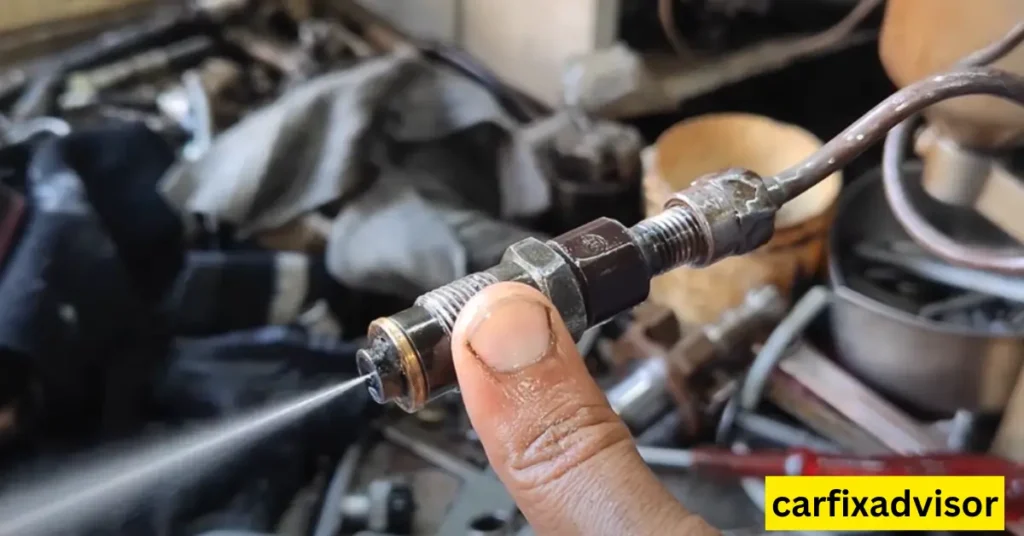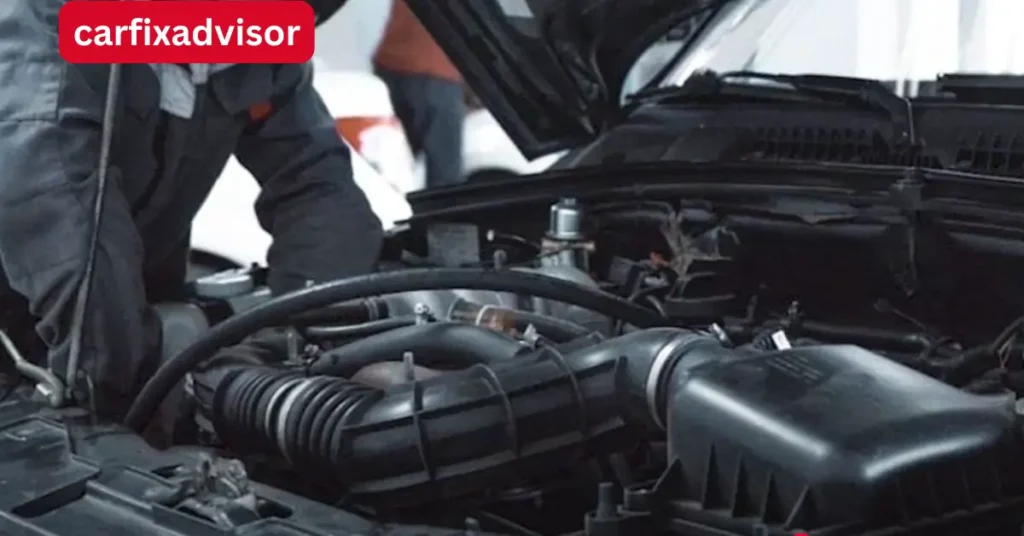When you add fuel injector cleaner to your car, you expect smoother engine performance, better fuel efficiency, and reduced emissions. But sometimes, your car sputters after fuel injector cleaner, which can be frustrating. While it may seem like the cleaner is to blame, several factors could cause this issue. In this article, we’ll explore why your car sputters after using a fuel injector cleaner, the possible causes, and how to fix the problem effectively.
What is Fuel Injector Cleaner?
Before diving into why your car sputters after using fuel injector cleaner, it’s important to understand what this product is and how it works.
Fuel injector cleaner is a liquid additive designed to remove carbon buildup, dirt, and deposits from the fuel injectors and fuel system. Over time, fuel injectors can become clogged with these impurities, leading to poor engine performance, decreased fuel efficiency, and increased emissions. By using a fuel injector cleaner, you can help restore proper injector function, making the engine run more smoothly.
Key Functions of Fuel Injector Cleaner:
Cleans dirt and carbon deposits from injectors
Restores fuel injector spray pattern
Improves fuel combustion and engine efficiency
Reduces engine misfires and sputtering
Most fuel injector cleaners are designed to be added to the gas tank, where they mix with the fuel and clean the injectors during normal engine operation.
Common Causes of Car Sputtering After Using Fuel Injector Cleaner
While fuel injector cleaners are generally safe and effective, there are several reasons why your car might sputter after using them. Understanding the causes can help you pinpoint the problem and find the right solution.
1. Excessive Carbon or Debris Removal
Fuel injectors and the fuel system accumulate carbon buildup over time. This buildup can cause injector clogging and poor engine performance. However, when a fuel injector cleaner is introduced, it can loosen and break up these deposits. If the carbon or debris is not properly flushed out, it can travel further into the fuel system or into the engine, leading to sputtering or rough idling.
How to Fix It:
Flush the Fuel System: If you suspect that debris is being pushed through the fuel system, it’s a good idea to have the system professionally flushed. This ensures that any loose carbon particles are removed completely, preventing them from causing further problems.
Use a Smaller Dose of Cleaner: If you’ve used too much fuel injector cleaner, it could cause too much debris to break loose at once. Consider using the product in smaller doses and repeating the treatment if necessary.
2. Incorrect Application of the Cleaner
Fuel injector cleaners work best when used according to the manufacturer’s instructions. If you add too much cleaner or the wrong type of cleaner for your car, it can affect how the cleaner works. For example, some fuel injector cleaners are not designed for modern vehicles with high-pressure injectors or direct fuel injection systems. In these cases, the cleaner could disrupt fuel flow and cause sputtering or misfiring.
How to Fix It:
Read the Instructions Carefully: Always follow the manufacturer’s instructions on the fuel injector cleaner bottle. Check for any specific recommendations for your vehicle model.
Choose the Right Cleaner: Make sure the cleaner you use is compatible with your car’s fuel system. For instance, some cleaners are designed specifically for diesel engines or high-performance vehicles.
3. Too Much Fuel Injector Cleaner
Using too much fuel injector cleaner can lead to excessive concentration, which may result in engine sputtering. A high concentration of cleaner in the fuel system could disturb the delicate balance of fuel and air needed for proper combustion.
How to Fix It:
Follow Recommended Dosages: Ensure that you add the correct amount of fuel injector cleaner based on the size of your gas tank. Overuse can lead to poor performance and may harm the engine in the long run.
Rinse and Refill: If you’ve accidentally added too much cleaner, dilute the mixture by filling the tank with more gasoline to reduce the cleaner’s concentration.
4. Clogged Fuel Filter
A clogged fuel filter can also be a contributing factor to sputtering after using a fuel injector cleaner. The cleaner may loosen debris or carbon deposits that were previously stuck in the filter. Once these particles become loose, they can clog the fuel filter and restrict the flow of fuel to the engine.
How to Fix It:
Replace the Fuel Filter: If you suspect that a clogged filter is causing the sputtering, replace the fuel filter as soon as possible. A clean filter ensures that fuel flows smoothly to the injectors and engine, preventing sputtering and misfires.
Regular Maintenance: Make it a habit to replace the fuel filter at regular intervals to prevent clogging from debris and carbon buildup.
5. Damaged or Worn-out Fuel Injectors
If your injectors are already worn or damaged, using a fuel injector cleaner might temporarily dislodge debris or worsen an existing problem. The cleaner may not be able to fully fix faulty injectors, leading to sputtering or rough engine performance.
How to Fix It:
Inspect and Replace Faulty Injectors: If your car sputters after using the cleaner, it might be time to inspect your fuel injectors. If they’re damaged, worn out, or clogged beyond repair, they may need to be replaced. A professional mechanic can perform injector testing to determine their condition.
6. Fuel System Imbalance
In some cases, fuel injectors may already be functioning poorly before the cleaner is introduced. If the injectors are not spraying fuel evenly or are leaking, the cleaner might exacerbate these problems by causing the injectors to work harder. This imbalance can cause the engine to sputter or run unevenly.
How to Fix It:
Professional Injector Testing: Have a professional mechanic test your injectors to ensure they’re operating within the correct parameters. If there’s an issue with fuel flow, repair or replacement might be necessary.
Fuel Pressure Testing: Low fuel pressure can also contribute to sputtering. A fuel pressure test can determine whether the fuel pump is delivering fuel at the correct pressure for optimal injector performance.
7. Overuse of Additives or Fuel Additives Incompatibility
Another common issue occurs when a vehicle owner uses multiple fuel additives, including fuel injector cleaners, in combination. Using too many additives at once can lead to an imbalance in the engine’s fuel system, potentially causing sputtering or erratic engine behavior. Additionally, some additives may not be compatible with each other or with certain engine types.
How to Fix It:
Limit Additive Use: Stick to a single fuel additive treatment when addressing fuel system issues. Overuse of additives can have a detrimental effect on your engine and cause unwanted issues like sputtering.
Check Compatibility: Ensure that any fuel additives you use are compatible with your vehicle’s engine type and fuel system. Consult your vehicle’s owner’s manual or a professional mechanic for recommendations.

8. Steps to Take If Your Car Sputters After Fuel Injector Cleaner
If your car begins sputtering after using a fuel injector cleaner, there are several steps you can take to diagnose and resolve the issue. These steps will guide you through understanding whether the problem is related to the cleaner itself or if there’s an underlying issue with your car’s fuel system.
a. Monitor the Symptoms and Timing
Before jumping into troubleshooting, observe when the sputtering occurs. Does it happen immediately after using the cleaner, or is it more noticeable after a few days of driving? Noting when the sputtering starts can give you valuable insight into whether the issue is directly related to the cleaner or whether it points to an existing problem with the vehicle.
Things to check:
When did the sputtering start (immediately after the cleaner or later)?
Is the sputtering constant or intermittent?
Does the sputtering happen at idle, during acceleration, or both?
This can help you decide whether to proceed with further cleaning, check the fuel system, or consult a mechanic.
b. Check the Fuel Injector Cleaner Dosage
One common reason cars sputter after using fuel injector cleaners is the incorrect dosage. Ensure that you’ve added the recommended amount of cleaner for your vehicle’s fuel tank size. Overusing the cleaner can cause it to be too concentrated, which can harm the engine or disrupt fuel flow. If you suspect you added too much cleaner, consider diluting it with more fuel.
Action steps:
Check the cleaner’s dosage instructions on the label.
If overused, add more gasoline to dilute the concentration.
Restart the car after a few minutes and check if the sputtering continues.
c. Inspect the Fuel System
Another step in troubleshooting sputtering is to inspect the fuel system for blockages, leaks, or damaged components. Fuel injectors that aren’t properly maintained can become clogged, affecting the fuel flow to the engine. A clogged fuel filter or worn-out injectors can exacerbate the issue when combined with the cleaner’s effects.
Things to inspect:
Fuel Filter: If the filter is clogged, it can restrict fuel flow, causing engine sputtering. Replacing a clogged fuel filter can often resolve this issue.
Fuel Injectors: Check if the injectors are spraying fuel properly. A professional mechanic can help test injector spray patterns and determine if they need cleaning or replacement.
Fuel Lines: Ensure that there are no leaks or cracks in the fuel lines that could affect pressure and fuel delivery.
If you notice any issues during the inspection, addressing these problems can improve your car’s performance.
9. When to Seek Professional Help
In some cases, fuel injector cleaner may not be enough to fix the sputtering, especially if the issue is related to more severe mechanical damage. While the cleaner is effective for many fuel system issues, it won’t resolve deeper problems such as worn-out injectors, a faulty fuel pump, or damaged fuel lines.
If the sputtering continues despite taking all the preventive measures and fixes discussed above, it’s time to seek professional help. A certified mechanic will be able to perform a detailed inspection of your fuel system and other engine components. They may conduct fuel pressure tests, check for leaks, and evaluate the condition of the injectors, filters, and fuel lines.
Signs that you need professional help:
Persistent sputtering even after fuel system flushing
No noticeable improvement after adjusting cleaner dosage
Engine misfires or failure to start
Mechanics can also use specialized diagnostic tools to determine if the fuel injectors are damaged or if there is a deeper issue, such as a malfunctioning fuel pump or damaged fuel pressure regulator.
10. Preventing Future Sputtering Issues
Once the issue causing the sputtering is resolved, it’s important to take proactive steps to prevent future occurrences. Regular maintenance and proper fuel system care can significantly reduce the likelihood of sputtering and improve overall engine performance. Here are some tips for long-term care:
a. Routine Fuel Injector Cleaning
Fuel injector cleaning should be a part of your car’s regular maintenance schedule. Using fuel injector cleaner periodically can help keep the injectors functioning properly and prevent carbon buildup. Many fuel injectors can last for tens of thousands of miles, but they need occasional cleaning to maintain optimal performance.
How to clean injectors regularly:
Follow the manufacturer’s guidelines for fuel injector cleaner use.
Schedule professional fuel system cleaning services every 30,000-50,000 miles (or as recommended by the vehicle manufacturer).
b. Regular Fuel Filter Replacement
Your fuel filter should be replaced regularly to avoid clogging and ensure the smooth operation of the fuel system. Over time, dirt, debris, and other contaminants can accumulate in the fuel filter, restricting fuel flow and causing the injectors to work harder than necessary.
Fuel filter replacement intervals:
Most vehicles require a fuel filter replacement every 30,000 to 60,000 miles.
Check your vehicle’s owner manual for the manufacturer’s recommended replacement interval.
c. Use Quality Fuel and Additives
Always use high-quality fuel from reputable gas stations. Low-quality fuel or fuel with contaminants can cause issues for your injectors and other engine components. Additionally, consider using fuel additives that help maintain the cleanliness of the fuel system, improve fuel efficiency, and reduce carbon buildup in the long term.
Fuel additive tips:
Look for fuel additives that are compatible with your engine type.
Use additives as a preventive measure, not a cure for existing issues.
Conclusion
If your car sputters after using a fuel injector cleaner, there are several potential causes, ranging from improper application of the cleaner to existing fuel system issues. By understanding these causes and taking corrective action, you can restore your car’s performance and prevent further issues.
To ensure the best results, always follow the manufacturer’s instructions for the fuel injector cleaner, and perform regular maintenance on your fuel system. If you continue to experience problems, it may be time to consult a professional mechanic to inspect and repair any damaged components, such as the injectors or fuel filter.
By addressing these issues promptly, you can maintain your car’s fuel efficiency, engine performance, and overall longevity.


